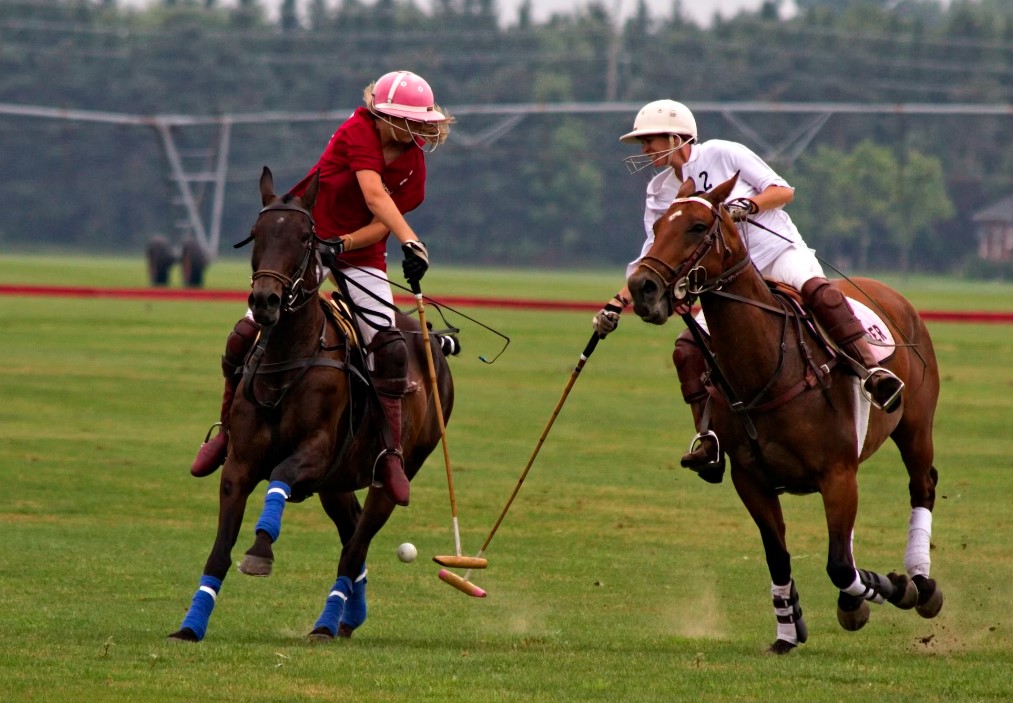Polo is known as the “sport of kings”, conjuring images of nobility on horseback. But behind polo’s refined facade lies a complex game requiring strategy and athleticism. This article explores polo’s intricate rules and captivating gameplay.
The Basics
Polo’s fundamentals are simple enough – two teams of four players each try to hit a ball through their opponent’s goal using long-handled mallets. Players score by driving the ball between goal posts, with matches consisting of 4-8 periods called “chukkers” lasting 7 minutes each. Teams change ends after each goal scored to compensate for wind and field conditions.
Matches are played on a grass field 300 yards long by 160 yards wide, the largest field in organized sports. Goal posts are set 8 yards apart at each end. Despite polo’s expansive playing area, all 8 players typically remain within a 60 yard section pursuing the ball, resulting in fierce competition for possession.
| Field Dimensions | Length | Width |
|---|---|---|
| Polo | 300 yards | 160 yards |
| Football | 120 yards | 53 1/3 yards |
| Soccer | 110-120 yards | 70-80 yards |
Specialized Positions
Each polo team has two primary positions – the #1 and #2 attack players who score most goals, and the #3 and #4 defenders who try preventing goals. The best player is usually the #3, responsible for both offense and defense.
The #1 position leads the attack and has right of way over other players. The #2 supports #1, feeding passes and blocking opponents. Defenders mark each attacking player, with the #3 guarding the lead attacker. The #4 defends against the #2 and backs up #3. This fluid man-to-man marking system creates thrilling matchups.
Right of Way
Polo’s strict right of way rules prevent collisions between galloping horses. The ball carrier has immediate right of way, followed by other players based on their distance from the ball. When players are equally distant, #1 has priority over #2, who has priority over #3, and so on.
Regardless of position, a player riding off the opponent’s right shoulder has right of way. Overtaking from any other angle is a foul. Horses must maintain their line once committed to the ball’s path. These intricacies require split-second decisions between keeping position and conceding right of way.
Penalties
Polo provides ample physicality combined with proper etiquette. Players cannot push, bump or ride off opponents. Rules limit contact to avoid endangering horses and riders. Illegal maneuvers draw penalties including free shots or ejection.
Yellow and red flag foul systems help officiate high-speed plays. A yellow flag indicates a possible infraction, stopping play so umpires can assess a penalty, ejection or red flag. A red flag is an immediate ejection for a severe infraction like unsportsmanlike conduct. Self-officiating is also encouraged, with players calling fouls on themselves. The spirit of integrity prevails in polo.
Handicapping
In polo, team handicaps balance competition. Individual players receive ratings from -2 to 10 based on horsemanship, hitting, team play, game sense and safety. Higher handicaps reflect greater skill and experience. Team handicaps sum each player’s rating, with the total goal score adjusted accordingly.
This system enables exciting matchups between teams with varied abilities. A 10 goal pro can play with three 0 goal novices against a balanced team whose ratings total 10. Handicaps transform polo into among the most egalitarian sports.
The Horses
Polo ponies are the unsung heroes of the sport. Strong, agile and intelligent, they play a pivotal role. Sturdy Thoroughbreds dominate polo. Their speed complements nimble quarter horses whose turning abilities are ideal for defensive players. Well-trained horses act on their own, following the ball, avoiding collisions and responding to riders’ cues.
Top polo ponies sell for up to £200,000. Their specialized training begins at age 3, strengthening muscles and leg bones to withstand polo’s demands. Most retire from competition by age 12. Polo relies on equine athletes as much as their riders.
All in all, beneath its genteel veneer, polo offers intense competition blended with respect for horses and sportsmanship. Complex right of way rules and team handicapping enable thrilling contests between players of all abilities. It’s a unique game combining elegant tradition with athletic rigor. Polo’s intricacies offer rewards for aficionados and newcomers alike.

Leave a Reply